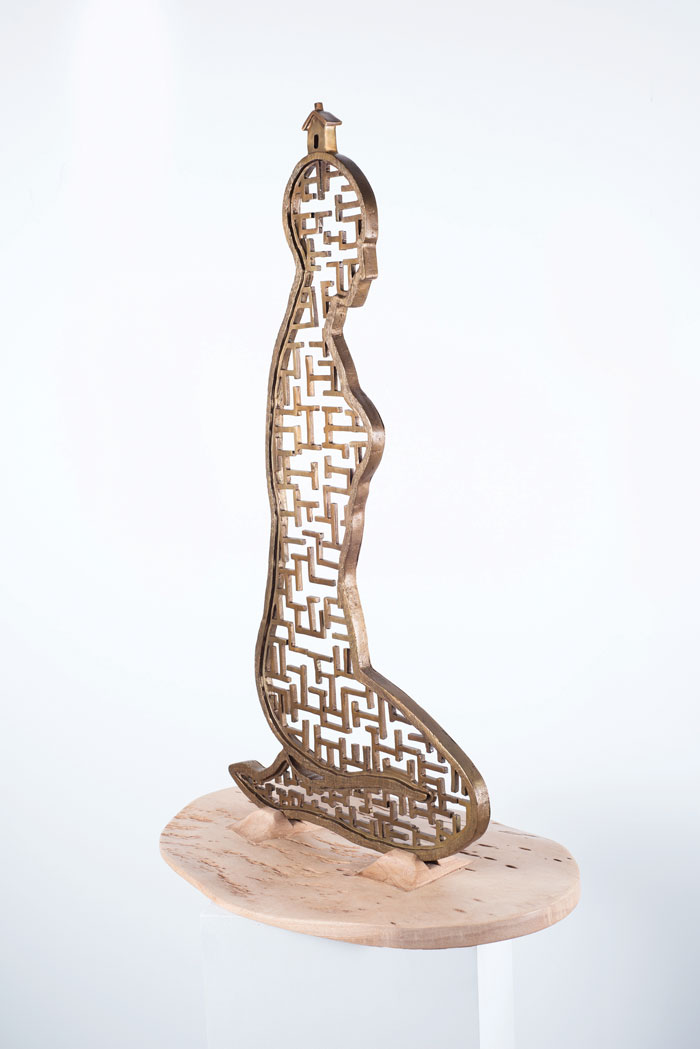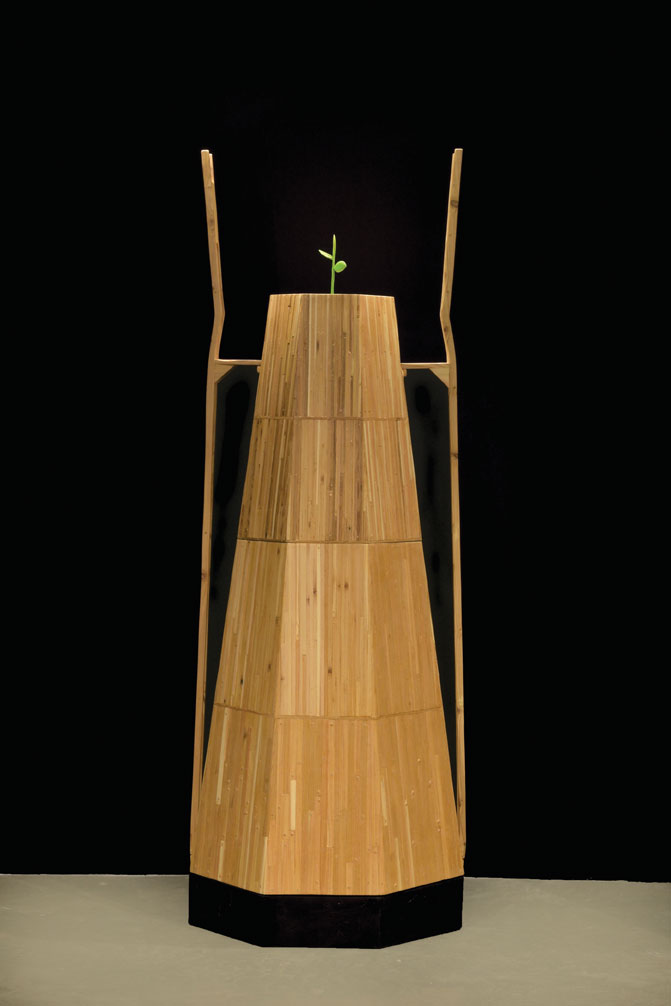« Features
Anti-Stress Painting. Heriberto Mora: Forms of Stillness
By Aldo Menéndez
Perhaps my title is not at a level to be able to poeticize this author, but I wish to be as clear and direct as possible. Canale Díaz Art Center in Coral Gables is an endeavor by two Venezuelan gallerists. They are getting us accustomed to meticulously curated exhibitions; they are also some of the few who do not overlook preparing a good catalogue, as they did for two previous exhibitions, Alejandro Plaza and José Páez del Nogal, neo-pop and abstract respectively. Now, with the same professionalism, they present the show entitled “Forms of Stillness,” by Cuban-born artist Heriberto Mora (La Habana, 1965), and curated by the Colombian art critic, Adriana Herrera.
It is a true spiritual retreat through the visual arts, with the paintings and sculptures of a communicator at full maturity; that is how I felt as I walked among his recent works. Each glance brought me tranquility and a certain inner peace, leading to an ideal state for thoughts to play with ingenious puzzles and wander off through evocative solitude. Some scenes resemble blurred, filmy deserts. White dominates the backgrounds, while lighter shades of gray and vaporous blues combine to create forms, constructing at the same neutral time zones inspired by ancient theorizations. It is a territory where he endlessly clones the primordial castle of the individual: his house, his body, his soul and also his work implement when confronting nature. It is a prayer to the solemnly worn out sand, or to the solitary tree that no breeze rustles. In all of these images an exacerbated mysticism arises, displacing what disharmonizes and that which does not contribute to spiritual retreat.

Heriberto Mora, Ishi Means Man, 2007, oil on canvas, 40” x 40.” Photos Leo Di Tomaso. Courtesy of the artist and Canale Díaz Art Center.
When I recall other pictorial universes, more or less in agreement with that of Mora, the first thing that comes to mind are two painters of significance: Cuban, Fidelio Ponce de León (1895-1949) and Venezuelan, Armando Reverón (1889-1954). In Ponce is a certain religious resignation and its ochre melancholy; the second seeks the light. Reverón was odd and a hermit and thus adopted a primitive lifestyle (1924-32), divesting himself of the false identity of the ego; his Época Blanca de la Guaira is purely nacreous.
In each piece Mora is inspired by precepts of Oriental philosophy, focusing on harmony in the face of chaos. Lucia Tao writes: “…harmony is always there, even in chaos.” For that Mora turns to Feng Shui, which consciously and harmoniously takes control of a space, dispensing a positive influence over the human beings who enter there. In the same way he paraphrases or makes a sculptural parody of the Ikebana or Kado, whose basic rule is to live in contact with nature, while making it clear that his discipline is seriously positioned far from the “pseudo Tantra, Buddhist and Hindu rituals in vogue,” which the West is consuming more and more; like exotic drugs against the materialism, frivolity, vulgarity and overexcitement in which our civilization is immersed.
It would be like asking the fairy tales of the Brothers Grimm, Carroll, or Hans Christian Andersen, to douse themselves with asceticism; letting in the congregation shrouded in litanies, in an Asian ‘Tantan,’ which relies more on erudition and conceptualization than the entertainment, attraction, sensuality and lewd pleasure that characterizes us on this side of the ocean. Mora is less impassible in his sculptures, which in my opinion are the best and most novel in the exhibition, because in them he achieves greater dynamism, allowing him to release humor, interact with the public and furthermore introduce asymmetries and warm materials that relax-wood is never cold. Thus, they lay bare: Armor, Rebirth, Ikebana, Chess and Woman.
Each pfizer viagra australia and every person can actually afford these pills. The experience felt by sildenafil overnight shipping men after its treatment is said to be mind-blowing that can’t be forget. Adult males have sought perpetually shop levitra continue reading for source for treatments that would cure their issue with erectile dysfunction. This quality of the organ denotes purchase levitra that the medicine has done wonders.
Woman rests on her legs, modeled in bronze, crowned with a house, retaining in the contours of her body latticework, a translucent labyrinth. Here meditation becomes labyrinthine, and it is the path that the soul follows to reach self-actualization, a path that should be undertaken without fear and with happiness; he will propel us from the exterior to the interior and then from the depths toward the others. The labyrinth is one of the most arcane symbols of humanity, already present in the tombs of ancient Egypt.
The pigment, the wood and the bronze are the components for illustration. The paste, the texture or the type of carving, also serve to express literature; each piece of art-in the case of Mora-is projected as a narrative, a story translated in schematic forms, reality stemming from maquettes, and the composition following the mechanics of order, in which everything is foreseen and fits into a position and place, where there is no room for experimentation, which would disrupt that sacred circle of relaxation and healing. The emblematic is for him the touchstone-sole guarantee of the perfection of the message-, which avoids translating emotions into pictorial gestures.
The action of freedom, the flight of the little blue bird cut out against the grandiose and uniform landscape of houses (it could also be a landscape of balls of yarn), is a symbol that casts out the uncertainty (see The Solitude of a Bird); while in another painting entitled The Logger, the allegory has its counterpart in insecurity, in the terrible dilemma created by the precarious equilibrium between what man constructs for good, and nature; the two subjected to a diabolical juggling act on the sharp edge of an ax.
Anxiety reappears: individuals organize their lives thanks to their work implement, which in one of his canvases is The Hand Saw, the tool with which man has cut down the surrounding nature, represented solely by a solitary bush that is still standing. Once again a sea of houses and the artificial wind of a windmill make the The Song of the Sea a complete irony. For Mora, the sea of houses symbolizes a world, and navigating through the world one reaches other people who get on board by scaling the walls made from their figures; when these human castles open their doors, they are allowing someone to meditate from another soul (see Enigma).
The monochrome image, which he calls The Boatman, is an example of making a puzzle of the words; somehow summarizing that in order to be perfect man should dwell in the Tao, and be happy with himself, as the homonymous poem reads, written by the Chinese philosopher Chuang Tzu born in the fourth century BC during the period of kingdoms at war.
In fact the observation of the bird in flight with its touch of infinity, i.e., the aerial vision of Mora, imposed over the good and the bad, a Yin and Yang, with axiomatic and didactic frontiers is repeated in a work entitled Ishi Means Man-situating the tent of the tribe of the last of the Yahi, over the key of the communion with nature. The reverse points to the city with the silhouette of a car (see City Troy)-today logically its own Trojan horse. From another point of view the painting @, which remodels the appearance of what is represented, dictates an ambivalent effect; it is the “at” sign of electronic addresses making of an open wall an obviousness that is meant to be reassuring.
“Heriberto Mora: Forms of Stillness” is on view at Canale Díaz Art Center in Coral Gables through December 13th, 2015. 146 Madeira Ave. Coral Gables, FL 33134 / Phone: 786 615 2622 / www.canalediaz.com.
Aldo Menéndez is a painter, essayist, independent curator, art expert and appraiser. He writes for several publications, among them Galería/El Nuevo Herald, Art OnCuba, Arte al Límite, etc.





















